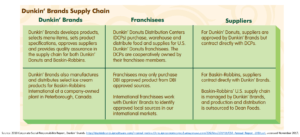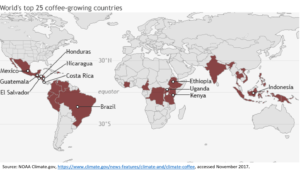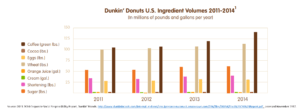A Hot Serving of Empty Promises? Dunkin’ Brands, the Enduring Foam Cups, and Sustainable Coffee

Dunkin’ Brands had made many commitments to address the impacts of climate change in its supply chain. Is this hot air in an empty cup, or a real push for sustainable coffee?
In 2010, Dunkin’ Brands declared the environmental impact of its polystyrene foam cups its number one sustainability priority.[1] Yet years later, Dunkin’ remains unprepared to transition to a more sustainable alternative. A petition on Change.org, started by fourth and fifth grade students from Massachusetts, called for Dunkin’ to end its use of foam cups by Earth Day, 2015. This petition garnered over 300,000 supporters, demonstrating the popular will and imperative for action on replacing the cups and on wider sustainability measures to address climate change across Dunkin’s supply chain.[2]
Dunkin’ Brands, the parent company of Dunkin’ Donuts and Baskin Robbins, serves as a franchisor of quick service restaurants specializing in coffee, bakery, and ice cream products.[3] The organization continues to grow rapidly and added 723 new restaurants globally in 2016; total points of distribution now exceed 20,000.[4] Sales of coffee products account for approximately 63% of Dunkin’ revenue and the company relies on sourcing 100% Arabica coffee to meet its customer demand.[5] In addition to public pressure to enact sustainability measures in its supply chain, like substituting the foam cup, Dunkin’ must also respond to the deleterious effects of climate change on global coffee production. Climate variability will not affect all Arabica coffee growing regions equally, although overall coffee production is expected to be negatively impacted and could result in supply instability and rising costs.[6]
Dunkin’s short and medium-term efforts to address climate change in its supply chain can generally be delineated into four categories: sustainable packaging, responsible sourcing, infrastructure, and replacing the foam cups.
In packaging, Dunkin’ issued its “Sustainable Pulp and Paper Policy” in 2016, which sets the goal of increasing from 60% to 80% packaging sourced from Sustainable Forestry Initiative sources by 2018.[7] Additionally, Dunkin’ partners with the Rainforest Alliance to help address climate sustainable sourcing of coffee. Dunkin’ granted over $310 thousand to Rainforest Alliance in recent years, supporting efforts to certify coffee farms on sustainable production and responding to climate change.[8] Dunkin’ recently expanded this cooperation, committing to using 100% Rainforest Alliance CertifiedTM expresso beans in all its products by the end of 2018.[9] Dunkin also plans to take steps to address deforestation that may contribute to climate change from its sourcing. Growth in the demand for palm oil has led to extensive deforestation of tropical forests to clear land for its cultivation.[10] Despite beinga limited user of palm oil, Dunkin’ committed to sourcing all palm oil in accordance with Roundtable on Sustainable Palm Oil (RSPO) criteria. For infrastructure, Dunkin’ committed in 2016 to significantly reduce energy and fuel usage in its corporate facilities and fleet by 2025. Specifically, the company is targeting a reduction of 30% energy used per square foot in facilities and a 9% increase in fuel efficiency in its corporate fleet respectively. [11]
Despite these initiatives, the enduring foam cup causes Dunkin’s commitment to addressing the environmental implications of its supply chain to appear empty. Without change, Dunkin’ will continue to contribute to the 25 billion foam cups discarded by Americans, causing environmental and climate harm.[12] Dunkin’ claims that no viable alternative to the foam cup currently exists that can meet the functional and cost requirements of its franchisees; nevertheless, Dunkin’ stakeholders, including corporate management and franchisees, should consider accepting an available higher cost alternative, while educating consumers on the sustainability benefits to the supply chain.
Furthermore, Dunkin’ could learn from its competitor, Starbucks, and focus on educating its consumers on the negative impacts of climate change on coffee farmers and production. On National Coffee Day 2017, Starbucks undertook a massive effort to reconfigure its stores to present information on menus about the climate challenges faced by farmers in its supply chain, and how it was helping to address them.[13] Dunkin’ should also follow Starbucks and commit to the Sustainable Coffee Challenge, a coalition of over 60 partners, including coffee producers, retailers, industry organizations, and non-governmental organizations, working together to make coffee the first truly sustainable agricultural product.[14] Finally, Dunkin’ could restructure future franchisee agreements to allow greater corporate influence over sustainability in the supply chain. Dunkin’ cites its inability to prescribe supply chain, energy and water use, and waste-management and recycling rules to its franchisees as a significant limitation to its influence over the enterprise.[15] Facing the systemic threats posed to brand reputation and the supply chain’s ability to reliably source coffee in the future due to climate change, Dunkin’ will need this additional flexibility to adapt policies over time to address changing circumstances.

Within this context, should Dunkin’s franchise ownership structure excuse the organization from being a leader in sustainability and climate change initiatives? Moreover, should consumers accept potentially more costly products from Dunkin’ to support corporate goals to address climate change in its supply chain?
(Word Count: 787)
[1] 2010 Corporate Social Responsibility Report, Dunkin’ Brands. http://dunkinbrands.iprsoftware.com/internal_redirect/cms.ipressroom.com.s3.amazonaws.com/226/files/201411/CSR_Annual_Report_2010.pdf, accessed November 2017.
[2] “Dunkin’ Donuts: Stop Using Styrofoam Cups.” Change.org, https://www.change.org/p/dunkin-donuts-stop-using-styrofoam-cups-15, accessed November 2017.
[3] Dunkin’ Brands. “About Us.” http://www.dunkinbrands.com/about, accessed November 2017.
[4] 2015-2016 Corporate Social Responsibility Report, Dunkin’ Brands. http://www.dunkinbrands.com/internal_redirect/cms.ipressroom.com.s3.amazonaws.com/226/files/20177/2016%20CSR%20Report.pdf, accessed November 2017.
[5] Rodrick, Stephen. “Average Joe.” New York Magazine (NYMag.com), http://nymag.com/nymetro/news/bizfinance/biz/features/15139/, accessed November 2017.
[6] Ovalle-Rivera O, Läderach P, Bunn C, Obersteiner M, and Schroth G. “Projected Shifts in Coffea arabica Suitability among Major Global Producing Regions Due to Climate Change.” PLoS One (Published April 2015), http://journals.plos.org/plosone/article?id=10.1371/journal.pone.0124155, accessed November 2017.
[7]2015-2016 Corporate Social Responsibility Report, Dunkin’ Brands. http://www.dunkinbrands.com/internal_redirect/cms.ipressroom.com.s3.amazonaws.com/226/files/20177/2016%20CSR%20Report.pdf, accessed November 2017.
[8] Dunkin’ Donuts. “Sustainability at Dunkin’ Donuts, Sustainability Fact Sheet May ’17.” https://news.dunkindonuts.com/internal_redirect/cms.ipressroom.com.s3.amazonaws.com/285/files/20174/Sustainability%20Fact%20Sheet%20May%20%2717.pdf, accessed November 2017.
[9] Dunkin’ Brands. “Our Planet.” http://www.dunkinbrands.com/responsibility/our-planet, accessed November 2017.
[10] May Tobin, Calen and Goodman, Lael. “Donuts, Deodorant, Deforestation.” Union of Concerned Scientists, (Published March 2014), pages 4-5. http://www.ucsusa.org/sites/default/files/legacy/assets/documents/global_warming/deforestation-free-palm-oil-scorecard.pdf, accessed November 2017.
[11] Dunkin’ Brands. “Our Planet.” http://www.dunkinbrands.com/responsibility/our-planet, accessed November 2017.
[12] McNall, Scott G. Rapid Climate Change: Causes, Consequences, and Solutions, (New York and London 2011, Routledge, Taylor & Francis Group), page 66. https://books.google.com/books?id=LL7C6fmNZgsC&pg=PA66&lpg=PA66&dq=do+styrofoam+cups+contribute+to+climate+change&source=bl&ots=RN_pYxgw37&sig=mtAwM_Zw2KNQrH3iIryKJqTvfN0&hl=en&sa=X&ved=0ahUKEwjOrLyH2brXAhXM3YMKHVn3DXA4ChDoAQhaMAk#v=onepage&q=do%20styrofoam%20cups%20contribute%20to%20climate%20change&f=false, accessed November 2017.
[13] Bach, Natasha. “Starbucks is Doing Something Different for National Coffee Day.” Fortune, September 29, 2017. http://fortune.com/2017/09/29/starbucks-national-coffee-day/, accessed November 2017.
[14] Starbucks. “Ethical Sourcing: Coffee.” https://www.starbucks.com/responsibility/sourcing/coffee, accessed November 2017.
[15]2015-2016 Corporate Social Responsibility Report, Dunkin’ Brands. http://www.dunkinbrands.com/internal_redirect/cms.ipressroom.com.s3.amazonaws.com/226/files/20177/2016%20CSR%20Report.pdf, accessed November 2017.





This is an interesting article and it brings to mind two thoughts:
1) Dunkin is/will be both a contributor to climate change (through its continued use of single use, non-recyclable foam cups) and a victim of climate change (through global warming effects on coffee beans and the associated cost and quality impacts). In a perfect ecosystem, Dunkin would be incentivized to modify its “bad” behavior but since the connection between foam cups –> global warming –> coffee beans is so convoluted and indirect, Dunkin really has no reason to stop using foam cups.
2) From a brand perspective, I could see their adherence to foam cups actually being an advantage. Given the current political attitude towards climate change (pulling out of Paris Agreement, climate change denial), I can think of a customer segment that views the cups as a symbol of protest against say, the elitist/overpriced Starbucks and their liberal customer segment. We will never know if this factors into Dunkin’s decision to keep the foam cups despite negative attention from the public, but I wouldn’t be surprised if it were!
I was so excited to hop on the bandwagon here- ‘Down with styrofoam!’ and similar such educated, eco-friendly perspectives. Unfortunately, then I did a quick Google search, and like most issues in climate change, I discovered that the problem is actually much more complex.
I’ve finally wrapped my head around the idea that recycling is not always more environmentally friendly (significant energy needed to turn our recyclable products back into something useful), and as it turns out, a similar rationale holds for the styrofoam vs paper cup debate. While styrofoam, as has become a handy green pop-culture fact, takes more than a million years to degrade in a landfill, it actually performs better than paper on many dimensions such as:
– Transportation fuel use (as it is lighter weight)
– Energy used to manufacture
– Water used to produced
As much as the coffee snob in me loves to hate on Dunkin (and it’s styrofoam cups), it seems like delaying/avoiding a switch paper might not be the worst decision here. That being said, Dunkin could definitely be doing more to actually address the problem, such as investing in development of styrofoam recycling technology.
https://www.bostonglobe.com/magazine/2014/04/02/why-paper-cups-just-aren-greener/W3TIBJ9dff8INlumPQvHSI/story.html
I agree with this comment above – we should think about environmental impact holistically from the true start to end of a product.
However, even if paper cups aren’t inherently better for the environment, I take issue with DD’s claim that there is no viable alternative. McDonald’s currently offers its coffee in paper cups (from what I can see on its website) [1]. Without getting too much into the weeds as I’m sure there are differences in the two company’s business models, I think it’s safe to say that Dunkin’ Donuts is more similar to McDonalds than it is to Starbucks. So if McDonalds can sell $1 coffee in a paper cup (compared to DD’s $1.59 for a small coffee), I would argue that there’s room for DD to follow suit. [2/3]
All in all, perhaps the argument about styrofoam is overblown. But, I do think companies should be held to higher standards when it comes to thinking about how they can and should adjust their legacy business model and practices to incorporate more sustainable practices. Claiming that it can’t work does not mean that the public should give companies a free pass.
[1] https://www.mcdonalds.com/us/en-us/product/coffee-small.html
[2] https://www.fastfoodmenuprices.com/dunkin-donuts-prices/
[3] https://www.fastfoodmenuprices.com/mcdonalds-prices/
Great article, I think you have highlighted a critical issue regarding the prevailing consensus on solving climate change. Specifically, we can’t expect solutions to be successful if they are not economically viable. It is not realistic to think that we can police every company to change cups. The real answer is to focus our efforts on developing new eco-friendly materials that are also cost competitive. If we can bring out new innovative solutions that save companies money, then we won’t have to worry about using social pressure to drive sustainable solutions.
This article raises an interesting question — who is to blame for such environmentally unfriendly practices: Dunkin’ Donuts? Or is it the likes of me and so many of my friends and colleagues who merrily order a medium hot coffee in said styrofoam cup everyday? I feel myself pointing the finger at the customers here and less so at Dunkin’. Surely, if we chose to penalize Dunkin’ by boycotting the brand for using environmentally unfriendly practices. We also have the option to walk into Dunkin’ Donuts with our Contigo mug, or some other thermos, to procure our beloved coffee. And yet, so few of us do. The truth is there is a fundamental convenience to walking out with a disposable cup that also protects your hand from the piping hot coffee inside (unlike its foe, Starbucks, and others). And we consumers love this convenience. But what if we took a step back and thought about the long-term effects of our convenient decisions we make everyday: styrofoam cups vs. stainless steel mugs, solar powered cars or more efficient fuel mileage vehicles vs. gas guzzling suburbans, and local-grown vegetables vs. those that have been sent cross country. So, tomorrow morning, consider carrying the Contigo mug into Dunkin’ Donuts, or, better yet, choose a brand that aligns with the environmental policies you want to see in the world. As consumers, we have a choice too.